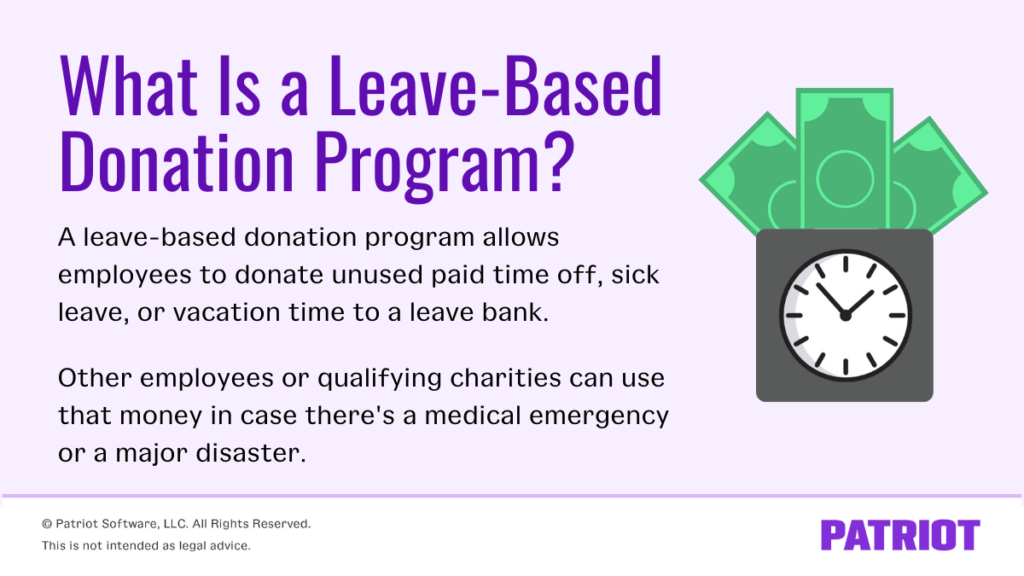Russia’s invasion of Ukraine has people across the U.S. thinking of ways to donate to the Ukrainian people. Businesses giving charitable donations, like money and property, are common. But, there are other ways to contribute. Employees can make PTO donations to Ukrainian refugees to help raise money for those in need.
Read on to learn about leave-based donation programs, major disaster leave benefits, and related tax relief.
What is a leave-based donation program?
A leave-based donation program allows employees to donate their unused paid time off, sick leave, or vacation time to a leave bank. Employers can then use that leave bank to make donations to eligible employees or qualifying charities under section 107(c).
There are two different types of leave banks you can choose:
- Medical emergency leave: For fellow employees who have experienced a medical emergency or suddenly need to care for a family member.
- Major disaster leave: For those that have been affected by a natural disaster. The president of the U.S. defines “Natural disaster”. These benefits include employees and qualifying non-employees (e.g., charities).
Now that you know about leave-based donation programs, let’s take a closer look at major disaster leave benefits and what that means for your business.

Major disaster leave benefits
Medical disaster leave benefits cover eligible employees. But, major disaster leave benefits can also include non-employees under unique conditions. When the president declares a natural disaster under the Stafford Act, eligibility for major disaster leave benefits expands to include non-employees.
Natural disasters can occur inside the U.S., like Hurricane Katrina, the California Wildfires of 2019, and COVID-19. They can also occur outside of the country and include human-made disasters such as the Ukraine Humanitarian Crisis.
Word to the wise: If a natural disaster strikes, the last thing you want to think about is your taxes. But, you may be eligible for IRS tax relief in disaster situations.
Tax-deductible donations to Ukraine: How it works
You may be wondering how leave-based donations to the Ukraine Humanitarian Crisis affect taxes. The IRS has helped answer any tax-related questions with Notice 2022-28. Employees and employers are affected differently.
What employees should know:
- Money removed from the appropriate leave bank before January 1, 2023 and donated to help victims of the Russian invasion of the Ukraine will not be treated as gross income, wages, or compensation of employees.
- Any employee who donates leave that funds payments will not be treated as having constructively received gross income, wages, or compensation.
- Employees aren’t eligible to claim a charitable contribution deduction under section 170(c) for the value of their leave contributed to the leave bank.
In other words, an employee can’t claim their contributions as charitable deductions, but they don’t have to pay taxes on the contributions regardless of whether they stay in the leave bank or are donated to the appropriate charities.
What employers should know:
- Don’t include the amount of qualified employer leave-based donation payments in Box 1, 3, or 5 of the electing employees’ Form W-2.
- You may deduct qualified employer leave-based donation payments if the charity meets the requirements of section 170(c).
Since the employee leave donations aren’t considered employee gross income, wages, or compensation, employers can’t include the amount on an employee’s Form W-2. But if the leave bank is used to make contributions to a qualifying charity, you can deduct that money as a charitable contribution deduction.
Interested in setting up PTO donations to Ukrainian refugees?
Setting up a leave donation program can enhance employee morale and camaraderie. And if your company doesn’t allow for leave benefits to be rolled over or bought out at year’s end, leave donation programs can give your employees an outlet for their unused leave.
But before you get started setting up a leave donation program, you may want to consider:
- Donor eligibility. Do workers have to make a certain amount or work for the company for a certain length of time before they can donate to the leave bank?
- Donation amounts. Is there a minimum or maximum that employees can donate to the leave bank? Is there a deadline for donations?
- Recipient eligibility. If your leave donation program is for employees, you may limit eligibility to workers that have been with the company for a certain length of time. You may also consider whether or not to include executives. If your leave donation program is for a specific major disaster, make sure your employees know who is eligible for donations (e.g., Ukrainian refugees)?
- Recipient amounts. When dealing with a leave donation program for employees, you may want to consider how much a recipient can receive at one time and if any of their income or leave comes into consideration. If your leave donation program is for a major disaster, you may set aside different percentages for different charities in the affected area (e.g., a charity that supplies jackets for children, bottled water, or medical checkups).
What your employees should know
Medical emergency leave banks and major disaster leave banks can be a great way for your employees to put their unused leave to work. But, as always, knowledge is power. Here’s a list of things your employees should know about your leave donation program.
If you decide to set up a leave bank that directly affects your employees, let them know:
- How the leave bank operates along with the rules for donations and payments
- Payments will be in the form of the recipient’s normal rate of pay
- Donors cannot direct their payments to specific recipients
- Employees cannot claim donations as an expense, tax deduction, or charitable donation
If you decide to set up a major disaster leave bank, with a specific disaster in mind, let your employees know:
- How the leave bank operates along with the rules for donations and payments
- Who the leave bank seeks to help and what charitable groups you will donate to
- Whether or not there is a timeline or a deadline for contributions
- Employees cannot claim donations as an expense, tax deduction, or charitable donation
This is not intended as legal advice; for more information, please click here.


